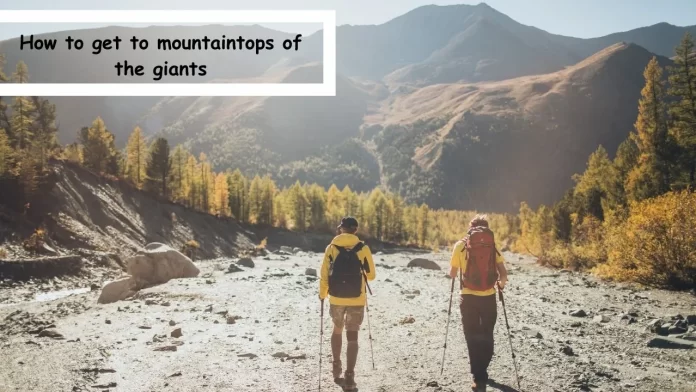If you’re an adventurer seeking breathtaking views and an exhilarating experience, How to get to mountaintops of the giants? might be just the expedition for you. Nestled in majestic ranges and peaks, these mountains offer awe-inspiring panoramas, pristine natural beauty, and a sense of accomplishment that comes with conquering lofty summits. Whether you’re a seasoned mountaineer or an enthusiastic hiker, reaching the mountaintops of the giants can be an unforgettable journey that pushes your physical limits and rewards you with unforgettable memories. In this guide, we’ll explore various routes, preparations, and tips to help you embark on this extraordinary quest and stand atop these towering giants. Lace up your boots, prepare your gear, and let the adventure begin!
What are the tallest mountains in the world?
The tallest mountains in the world are:
- Mount Everest (8,848.86 metres or 29,031.7 feet) – Located in the Himalayas on the border of Nepal and China (Tibet Autonomous Region).
- K2 (8,611 metres or 28,251 feet) – Located on the China -Pakistan border in the Karakoram Range.
- Kangchenjunga (8,586 metres or 28,169 feet) – Situated on the border of Nepal and India in the Eastern Himalayas.
- Lhotse (8,516 metres or 27,940 feet) – Located in the Everest region of the Himalayas, adjacent to Mount Everest.
- Makalu (8,485 metres or 27,838 feet) – Situated in the Mahalangur Himalayas, southeast of Mount Everest.
These mountains are part of the Eight-thousanders, a group of 14 mountains globally recognized for their towering heights above 8,000 metres (26,247 feet). They are among the most challenging and renowned peaks for mountaineering enthusiasts around the world.
What are some famous mountain ranges known for their towering peaks?
There are several famous mountain ranges known for their towering peaks. Some of them include:
- The Himalayas: This mountain range stretches across several countries, including Nepal, India, Bhutan, China (Tibet), and Pakistan. It is home to the highest peak in the world, Mount Everest, along with numerous other majestic mountains.
- The Andes: Spanning across several South American countries, including Argentina, Chile, Peru, Ecuador, and Colombia, the Andes is the longest mountain range in the world. It is renowned for its dramatic peaks, including Aconcagua, the highest mountain outside of Asia.
- The Rocky Mountains: Stretching from western Canada down to the southwestern United States, the Rocky Mountains boast impressive peaks, such as Mount Elbert in Colorado and Mount Robson in Canada.
- The Alps: Situated primarily in Europe, the Alps cover several countries, including France, Switzerland, Italy, Austria, and Germany. This iconic mountain range is famous for its picturesque landscapes and notable peaks like Mont Blanc.
- The Karakoram Range: Located in the borders of Pakistan, China (Xinjiang region), and India, the Karakoram Range features some of the world’s most challenging and awe-inspiring peaks, including K2, the second highest mountain in the world.
- The Sierra Nevada: Situated in California, United States, the Sierra Nevada range is known for its majestic granite peaks, including Mount Whitney, the highest peak in the contiguous United States.
These are just a few examples of famous mountain ranges known for their towering peaks. Each range offers unique natural beauty and attracts mountaineers, hikers, and nature enthusiasts from around the globe.
How long does it take to climb Mount Everest?
The duration to climb Mount Everest can vary depending on several factors, including the climber’s experience, fitness level, weather conditions, and the specific route chosen. Typically, a successful ascent of Mount Everest takes around 60 to 70 days from the start of the expedition to reaching the summit and descending back to the base camp. This time frame includes acclimatisation periods, establishing higher camps, and waiting for suitable weather windows for summit attempts.
The actual climbing period from the base camp to the summit usually takes around 6 to 8 weeks. This includes multiple rotations between camps at higher altitudes to gradually acclimatise to the extreme conditions and reduce the risk of altitude sickness. Climbers also need to allow time for rest and recovery during the ascent to maintain their strength and stamina.
It’s important to note that these timeframes are estimates and can vary for each climber and expedition. Some experienced climbers may attempt speed ascents with shorter timelines, while others may require more time for acclimatisation or due to weather-related delays. Additionally, climbers need to consider the pre-expedition preparations, such as training, travel, and logistical arrangements, which can add to the overall duration of the Mount Everest climbing experience.
What are the essential gear and equipment needed for climbing high mountains?
Climbing high mountains requires specialised gear and equipment to ensure safety and comfort in challenging environments. Here are some essential items climbers typically need:
- Mountaineering Boots: Sturdy and waterproof boots designed for mountaineering to provide support, insulation, and traction on various terrains.
- Crampons: Metal spikes that attach to boots for traction on icy or snowy surfaces.
- Ice Axe: A versatile tool used for self-arresting during falls, cutting steps, and providing stability on steep slopes.
- Climbing Harness: A harness that fits securely around the waist and legs, allowing climbers to attach themselves to ropes and anchors.
- Helmet: A protective helmet to guard against falling rocks, ice, or other hazards.
- Ropes and Carabiners: Essential for securing climbers to anchors and each other during roped sections of the climb.
- Layers of Clothing: A combination of base layers, mid-layers, and outer layers to provide insulation, breathability, and protection from the elements. This includes moisture-wicking base layers, insulating mid-layers, and waterproof and windproof outer shells.
- Backpack: A sturdy and spacious backpack to carry essential gear, food, water, extra clothing, and other personal items.
- Sleeping Bag and Pad: A high-quality sleeping bag and sleeping pad for comfortable rest during overnight stays at high altitudes.
- Headlamp: A reliable headlamp with extra batteries for visibility during early morning starts, late finishes, or night climbs.
- Sunglasses and Sunscreen: UV-blocking sunglasses to protect eyes from intense sunlight and sunscreen to shield exposed skin from harmful UV rays at high altitudes.
- Navigation Tools: Maps, compass, and GPS device to navigate and stay on route.
- First Aid Kit: A well-equipped first aid kit tailored for mountaineering, including essentials like bandages, medications, blister treatments, and altitude sickness medication.
- Food and Water: High-energy and lightweight food options to sustain energy levels and hydration systems to ensure an adequate water supply.
- Communication Devices: A mobile phone, satellite phone, or two-way radio for emergencies and communication with support teams.
It’s crucial for climbers to have proper training, knowledge, and experience in using the equipment listed above.
Are there age restrictions or physical fitness requirements for climbing the mountaintops of the giants?
How to get to mountaintops of the giants, such as the highest peaks in the world like Mount Everest, often have age restrictions and physical fitness requirements due to the extreme nature of the climbs. Here are some considerations:
- Age Restrictions: Many expeditions have minimum age requirements to ensure climbers have the physical and mental maturity to handle the challenges of high-altitude mountaineering. For example, on Mount Everest, climbers are typically required to be at least 18 years old. However, age restrictions may vary depending on the specific mountain and expedition.
- Physical Fitness: Climbing high mountains requires a high level of physical fitness and endurance. Mountaineers must be able to endure prolonged physical exertion, cope with extreme weather conditions, and handle the effects of high altitude. While there may not be strict fitness tests, climbers are expected to be in good health, have a solid aerobic capacity, and possess strength and stamina necessary for the demanding ascent.
- Altitude Experience: Some mountains may require climbers to have prior high-altitude mountaineering experience. This is especially true for more challenging peaks. Previous experience at high altitudes helps climbers understand the risks and effects of altitude on their bodies and better prepares them for the physical and mental demands of the climb.
- Technical Skills: Certain mountains may have technical sections that require specific climbing skills, such as ice climbing or rock climbing. Climbers may need to demonstrate proficiency in these skills or have prior experience with technical climbing.
It’s important to note that requirements can vary between different mountains, expeditions, and guiding companies. It is recommended to consult with experienced mountaineers or professional guides who can provide detailed information about age restrictions, physical fitness expectations, and technical skill requirements for specific mountain climbs. Proper training, preparation, and acclimatisation are essential for a safe and successful mountaineering experience.
Can I climb the mountaintops of the giants without prior mountaineering experience?
Climbing the mountaintops of the giants without prior mountaineering experience can be extremely challenging and potentially dangerous. How to get to mountaintops of the giants? These mountains, such as Mount Everest and other high peaks, present significant risks and require specialised skills and knowledge. Here are some factors to consider:
- Technical Skills: High-altitude mountaineering often involves technical climbing, including navigating steep and icy terrain, using ropes and other climbing equipment, and dealing with potentially hazardous conditions. Without prior experience and training, it can be difficult to safely navigate these challenges.
- Physical Demands: Climbing high mountains requires a high level of physical fitness and endurance. It involves prolonged periods of strenuous physical exertion, often at high altitudes where the oxygen levels are lower. Without proper physical preparation, it can be extremely difficult to cope with the demanding physical requirements.
- Altitude Acclimatisation: Ascending to high altitudes without proper acclimatisation can lead to serious health risks, including altitude sickness. Acclimatization involves gradually ascending to higher elevations, allowing the body to adapt to the reduced oxygen levels. Without prior experience or guidance, it can be challenging to understand and manage the effects of altitude on the body.
- Safety and Navigation: Climbing high mountains requires knowledge of safety protocols, emergency procedures, and navigation skills. These skills are crucial for managing risks and ensuring a safe ascent and descent. Without prior mountaineering experience, it may be challenging to make informed decisions and respond to unexpected situations.
If you are interested in climbing the mountaintops of the giants, it is strongly recommended to gain prior mountaineering experience, develop technical skills, and undergo proper training and preparation. Joining guided expeditions or seeking mentorship from experienced mountaineers can provide valuable guidance and support. Remember that mountaineering is a challenging and potentially risky activity, and prioritising safety should always be the top concern.
What is the best time of year to attempt climbing the mountaintops of the giants?
The best time of year to attempt climbing the mountaintops of the giants can vary depending on the specific mountain and its geographical location. Here are some considerations for choosing the optimal time:
Weather and Climatic Conditions: It is essential to consider the weather patterns and climatic conditions of the mountain range you intend to climb. Typically, the most favourable weather windows for climbing are during the mountain’s respective climbing season when conditions are relatively stable. For example, on Mount Everest, the primary climbing seasons are in the spring (April to May) and autumn (September to October) when the weather tends to be more predictable with milder temperatures and less precipitation.
Route and Objective: Different routes on the same mountain may have varying optimal climbing seasons. Research the specific route you plan to take and consult with experienced mountaineers or guide services to determine the recommended time of year for that particular route.
Crowds and Permit Availability: Consider the popularity and demand for climbing permits during different times of the year. Some mountains, like Mount Everest, may have limited permits available, and the climbing season can become crowded. Planning your climb during less busy periods can provide a more enjoyable and less congested experience.
Personal Preference and Experience: Your personal preferences and experience level also play a role in choosing the best time to climb. Some climbers may prefer colder conditions and more challenging winter ascents, while others may opt for milder temperatures during the climbing season. Consider your comfort level and ability to cope with the specific conditions of the mountain.
It is crucial to gather as much information as possible about the mountain you plan to climb, including weather patterns, climbing seasons, permit requirements, and safety considerations. Consulting with experienced mountaineers, local guides, or expedition companies can provide valuable insights and help you determine the best time of year for your climbing objective.
Frequently Ask Questions FAQs
Q: What are the mountaintops of the giants?
A: The mountaintops of the giants refer to the highest peaks in the world, such as Mount Everest, K2, Kangchenjunga, and other towering mountains known for their extreme altitudes and challenging climbing conditions.
Q: How can I reach the mountaintops of the giants?
A: Reaching the mountaintops of the giants typically involves extensive planning, preparation, and mountaineering expertise. It requires a combination of physical training, technical climbing skills, logistical arrangements, and often joining guided expeditions or hiring experienced mountaineering teams.
Q: Can anyone attempt to climb the mountaintops of the giants?
A: Climbing the mountaintops of the giants is an incredibly challenging and demanding endeavour. It requires a high level of physical fitness, mountaineering experience, and appropriate training. It is not recommended for beginners or individuals without prior mountaineering experience.
Q: Do I need a permit to climb the mountaintops of the giants?
A: Yes, most mountains in the world require climbing permits, including the mountaintops of the giants. These permits are usually obtained through authorised organisations or government agencies responsible for managing mountaineering activities in the respective regions.
Q: Are there established routes to reach the mountaintops of the giants?
A: Yes, there are established climbing routes to reach the mountaintops of the giants. These routes may vary in difficulty and technicality. Each mountain has its own standard routes, and climbers usually follow these established paths to ensure safety and efficient progress.
Q: How long does it take to reach the mountaintops of the giants?
A: The duration to reach the mountaintops of the giants varies depending on factors such as the mountain’s elevation, the chosen route, weather conditions, acclimatisation needs, and the climber’s experience. Expeditions can take several weeks or even months to complete.







